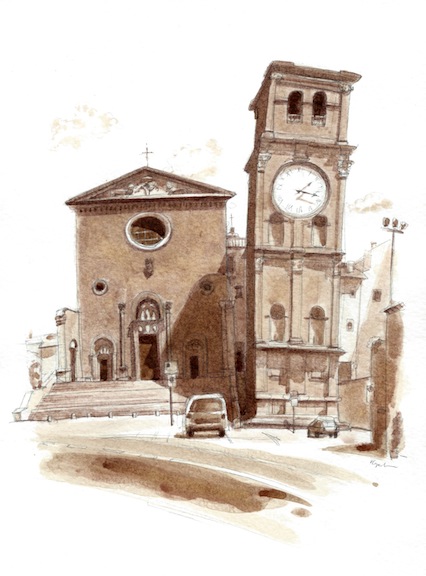
The Basilica of La Quercia is completely oversized for its tiny village. It looms over a quiet crossroad on the outskirts of Viterbo, with a couple dozen scrappy houses around it. The entire population of little La Quercia couldn’t possibly fill the church – probably not even half of it, or less. However, this isn’t a church for the village – it’s a church for miracles.
Here in 1417, a local wealthy landowner, Mastro Battista Magnano Juzzante, nailed a painting to an oak tree (La Quercia means “the Oak”) which was at the edge of his vineyard. Perhaps it was to comfort the pilgrims who passed by regularly on the way to Viterbo, and then on to Rome. Or maybe, it was a conscience-raiser for thieves known to prowl the area. Either way, it was a small gesture, and it was a small painting – created on a roof tile, depicting the Madonna and Child.
Not long after it was hung, a local hermit took a liking to the artwork, and stole it back to his cave. He prayed to the image before going to sleep, and when he woke up, it was gone. Later, he came to discover that the painting was surprisingly back on the tree!
After some time, a woman by the name of Bartolomea took the painting. She too, prayed to the painting at night, and found it missing in the morning. She had heard the story of the hermit and ran back to the tree, only to find the painting hanging there again! She took the painting home a second time, and the very next day, it had returned again. She kept the secret of the two incidents to herself until 1467, when yet another miracle occured.
A horseman was being chased from Viterbo by enemies when he saw the large oak tree ahead. Arriving before of the evil pursuers, he jumped down off his horse, hugged the tree, and prayed to the Virgin Mary for help. Upon arrival, the bad guys found the man’s horse, but not him. He had become invisible. Later, the horseman rode back to town to exclaim the power of the painting on the tree, and the reputation of the miraculous painting started to grow.
Later that year, the plague known as the Black Death swept the area. Fearing for their lives, Viterbo residents (and beyond) rushed to the oak tree to pray for healing. One historian claimed that 30,000 people came, and that the plague disappeared within days. Soon 40,000 people came from far and wide to pray in thankfulness.
Before long, an altar was built by the tree. Then, a chapel. And in 1593, the huge church was erected to celebrate the miraculous image of the Madonna and Child. A monastary, a cloister and an impressive campinile (a freestanding bell tower) followed, and were visited by popes, future saints, and masses of pilgrims.
The church had some hard times ahead, despite the protective image. Gold, silver and jewels were stolen from the church on Christmas night of the year 1700. Napolean’s soldiers roughed up the place in 1800. And the church was very nearly bombed on January 20,1942, during World War II.
But what remains to this day, nearly 600 years later, is the Madonna della Quercia – a small painting on a roof tile, glorified and enshrined, along with a few remnants of the oak tree from which it hung.


Поделиться
Recent Posts
#USkSeptemberPrompts2024
Each day this September, explore a new prompt to kickstart...
Читать далееDrawing Attention September 2024
Drawing Attention, официальный журнал организации Urban Sketchers, передает...
Читать далееОбъявляется конкурс на должность вице-президента Urban Sketchers (должность волонтера)
Want to make a difference? Have a knack for leadership? Keen...
Читать далееArriving in Buenos Aires – What to Expect
Figuring out what the local currency is and how best to...
Читать далее